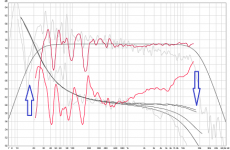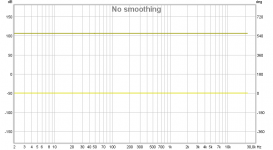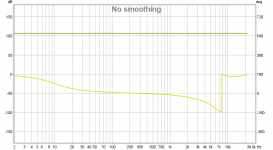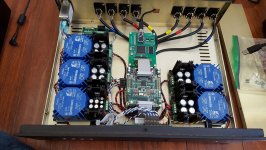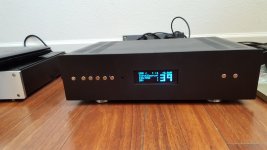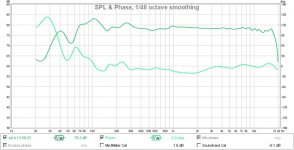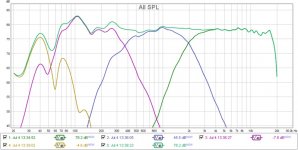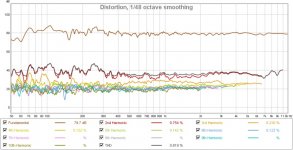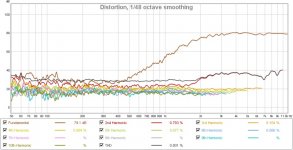jojip,
As a phase test comparison here two short ACDC wav-file sound clips, one is normal and one have phase turned, they uploaded as dot asc-file which allow larger file size than example a zip folder so to play them after download rename extension to dot wav.
As a phase test comparison here two short ACDC wav-file sound clips, one is normal and one have phase turned, they uploaded as dot asc-file which allow larger file size than example a zip folder so to play them after download rename extension to dot wav.
Attachments
jojip,
As a phase test comparison here two short ACDC wav-file sound clips, one is normal and one have phase turned, they uploaded as dot asc-file which allow larger file size than example a zip folder so to play them after download rename extension to dot wav.
Thanks BYRTT for the tracks. Difference is very subtle and hard to grasp as the tracks are small. But i do sense that the phase turned version is a bit off.
earlier I had changed my rephase filters to remove the upward phase in the HF as you had suggested. I will try your tracks again with the old filters with the rising phase curve
This looks like a potential concern. We cannot hear smooth and gentle changes in phase typical of a well designed mid/tweeter crossover (not necessarily the case at low frequencies) but it is possible to create audible issues with symmetric FIR filters used to monkey about with the phase through a crossover. It will depend on the form of the filters being generated by your software. To check we can look at the impulse responses for the tweeter, mid and mid+tweeter both on-axis and significantly off-axis (things that cancel perfectly on-axis probably won't off-axis). If you have significant pre-ringing (i.e. the tweeter and woofer moving around before the sound arrives) then you will hear that particularly on impulsive sounds.Thanks BYRTT for the tracks. Difference is very subtle and hard to grasp as the tracks are small. But i do sense that the phase turned version is a bit off.
earlier I had changed my rephase filters to remove the upward phase in the HF as you had suggested. I will try your tracks again with the old filters with the rising phase curve
What waggles our eardrums in a room is mainly indirect sound not direct sound although the brain tends to pay more attention to the direct sound. The frequency response of that sound follows from the directivity of the speakers. The on and off-axis frequency response dominates how a speaker sounds that is not being overdriven. It is pretty much the only thing that Toole considers in his book on the sound of speakers in rooms. The room of course influences the indirect sound.
Some test tracks here if this is the sort of thing you are after?
Over 75 dB the tweeter is not clear but it is below? Unless you are long way away in a large room that seems to be too low a level for it to be the tweeter running out of displacement and generating high distortion. The 2 kHz crossover frequency with 24 dB/octave slopes is on the low side but doesn't look a problem. Changing with level indicates a non-linear problem and the obvious one there is the midrange resonance which tests show not to be the case. Am I right in saying you are hearing a lack of clarity but not measuring a noticeable rise in measured distortion? If so, we almost certainly need to be looking elsewhere.
The W15 is a woofer/midwoofer rather than a midrange and so the 300 Hz high pass is no problem at all. The sensitivity and the maximum SPL is more of a concern for a large speaker. It will be the driver that starts to distort first and at a significantly lower level than a conventional decent midrange. As a rule of thumb you are looking at a 6 dB drop at 2m, a 12 dB drop at 4m and peaks roughly 20dB above average levels. So if your 75 dB level is an average one at 4m then the peaks at 1m will be 75+12+20 = 107 dB which is starting to reach the limits of your insensitive midrange. If this is to be the cause it must show in relevant distortion measurements.
Restricted space behind the midrange has the potential to cause issues. Here are some measurements suggesting what to look for. I am not sure how you would test if this is the cause. Perhaps by reblocking and if you can hear no change then it is not the problem?
To repeat something I asked earlier that may not have been understood. Are you using symmetric FIR filters with a significant number of coefficients in the crossover? If so, that may be the problem but it is a linear effect and so would be expected to be present at all SPLs.
Thanks for the test tracks link. Very useful.
I will be making some room improvements like carpets and curtains.
My observation on the tweeter might have been a perception of the bump in the midrange distortion(which was eventually addressed for subtle improvement). I would still have preferred a higher XO with this tweeter, but CTC issue and change in directivity at the XO might become a concern.
I will post distortion measurement at 90db or higher as suggested. This should show what the insensitive midrange is doing at high SPL.
I am using symmetric LR4 FIR filters for all XOs, will have to go back and check on the number of coeff. How does this influence sound quality?
Another observation I had made earlier was that the speakers sound dull and lifeless at low volumes. They need a fair bit of volume to sound enjoyable. Does the low sensitivity explain this?
And the reasons for poorer SQ on busy complex tracks compared to slow simple tracks still remains a mystery.
Btw, what measurements are indicative of a Midrange drivers transient response? Intuitively a driver with very light yet stiff cone, damped surround/spider and powerful motor sound like the attributes to me, am I off?
Here is wish list of midrange drivers, one of which I want to try sometime in future to replace the W15 85.5db
1. New SB Satori midrange MR13P 91db (seems like a value driver)
2. Seas MC15RCY 89.5 db (seems like this doesn’t have a fancy motor design)
3. Seas M15CH002 88.5 db (also has very narrow Nd magnet) (Pricey****)
4. Dayton RS150P-4 91.8 db (Not the same league, but is expensive and measurements look decent, power handling is a concern?)
Comments on these drivers? Not planning on plunking anymore cash at this point, but exploring good midranges.
The new 6” Satori midrange with Seas T35C002 tweeter also seems like a good combo in a three-way.
jojip,
Thanks feedback and you right hard to grasp when tracks are so short, but also in you have changed filters now that counter for the case and makes test less worth.
Should you be curious do it yourself i copied method shared by member wesayso at some thread and here is recipe: Thick of any filters in JRiver engine except the convolution filter effect and make shure not to use any sample rate converting, then as playback option use "Diskwriter" and configure it to output stereo-file. Then play a track that need the filter added, operation is very fast in time and creates the new track in folder "JRiver Disk Writes" placed in your Windows profiles "Music" folder.
Attach the used filter below for 44,1kHz CD tracks should you want to hear your own track in full length, the other is neutral IR i used on the "NORMAL" track because convolution can change a bit into tracks spl level, so to have reference and phased track under comparison play at same level running them both thru convolution engine with phased and neutral filter ensure same track levels.
Thanks feedback and you right hard to grasp when tracks are so short, but also in you have changed filters now that counter for the case and makes test less worth.
Should you be curious do it yourself i copied method shared by member wesayso at some thread and here is recipe: Thick of any filters in JRiver engine except the convolution filter effect and make shure not to use any sample rate converting, then as playback option use "Diskwriter" and configure it to output stereo-file. Then play a track that need the filter added, operation is very fast in time and creates the new track in folder "JRiver Disk Writes" placed in your Windows profiles "Music" folder.
Attach the used filter below for 44,1kHz CD tracks should you want to hear your own track in full length, the other is neutral IR i used on the "NORMAL" track because convolution can change a bit into tracks spl level, so to have reference and phased track under comparison play at same level running them both thru convolution engine with phased and neutral filter ensure same track levels.
Attachments
On this website, the T25CF001 tweeter's measured distortion at around 100db spl is -50db above 2KHz
??-????????
But when i make a distortion measurement of this driver in the enclosure (no filters) I get THD (dominated by 2nd) at around -38 db for a sweep at 80db
what could explain this elevated distortion in my setup?
the measurement was using focusrite 2i2 as ext soundcard and ncore400 as the amp
??-????????
But when i make a distortion measurement of this driver in the enclosure (no filters) I get THD (dominated by 2nd) at around -38 db for a sweep at 80db
what could explain this elevated distortion in my setup?
the measurement was using focusrite 2i2 as ext soundcard and ncore400 as the amp
Last edited:
Overall i still perceive something lacking in the sound.
The mid/tweeter still doesnt sound clean and smooth.
Particularly the tweeter range.
I am still unclear about the issue.
I understand that the subwoofer integration is off and needs some work. But whats still a mystery is whats going on higher up.
The reflective room does play a role, but i think my ears are able to tune them out. The roughness, recessed SQ in the higher ranges is probably something else.
Its possible that my build of the nc400 amp is under some form of EMI/RFI distress and dumping distortions into the mid/tweeter. Dont know if i can measure the amp reliably with the tools i have. Will see if i can get an alternative amp to try out.
Whether the drivers themselves are limiting in some way is also unclear. Though i do wish to hear what difference a sensitive midrange of paper or polyprop might make.
These impressive drivers have been add to my wishlist
WF152BD03_04
TW030WA11_12
The mid/tweeter still doesnt sound clean and smooth.
Particularly the tweeter range.
I am still unclear about the issue.
I understand that the subwoofer integration is off and needs some work. But whats still a mystery is whats going on higher up.
The reflective room does play a role, but i think my ears are able to tune them out. The roughness, recessed SQ in the higher ranges is probably something else.
Its possible that my build of the nc400 amp is under some form of EMI/RFI distress and dumping distortions into the mid/tweeter. Dont know if i can measure the amp reliably with the tools i have. Will see if i can get an alternative amp to try out.
Whether the drivers themselves are limiting in some way is also unclear. Though i do wish to hear what difference a sensitive midrange of paper or polyprop might make.
These impressive drivers have been add to my wishlist
WF152BD03_04
TW030WA11_12
WOW DAC is beautiful hardware : )
Regarding distortion what comes to mind is new DAC is USB device and so is UMIK-1 running their separated clocks and if they run at different sample rate normal give little penalty in distortion area but probably not so much.
Also sometimes has experienced a shift from one physical port to another does wonder or disable power management for USB ports in device manger and power profiles. Free tools "DPC Latency Checker" and "Thesycon USB Descriptor Dumper" from Thesycon - USB Software Development for Windows Operating Systems can often analyze for any problems.
Then bwaslo have these good advices and warnings for USB setup that can steal bits under Win8 and Win10 and has to be set into WinXP SP3 mode to fix problem http://www.diyaudio.com/forums/multi-way/283068-mini-synergy-horn-experiment-11.html#post4547997.
Regarding distortion what comes to mind is new DAC is USB device and so is UMIK-1 running their separated clocks and if they run at different sample rate normal give little penalty in distortion area but probably not so much.
Also sometimes has experienced a shift from one physical port to another does wonder or disable power management for USB ports in device manger and power profiles. Free tools "DPC Latency Checker" and "Thesycon USB Descriptor Dumper" from Thesycon - USB Software Development for Windows Operating Systems can often analyze for any problems.
Then bwaslo have these good advices and warnings for USB setup that can steal bits under Win8 and Win10 and has to be set into WinXP SP3 mode to fix problem http://www.diyaudio.com/forums/multi-way/283068-mini-synergy-horn-experiment-11.html#post4547997.
What happens if you do measure the tweeter closer to 100dB? Funnier things have happened but sometimes an increase in drive level, and signal to noise ratio, can change things. It's also possible that you're seeing 2nd harmonic from a systematic error with your measuring equipment.
What happens if you do measure the tweeter closer to 100dB? Funnier things have happened but sometimes an increase in drive level, and signal to noise ratio, can change things. It's also possible that you're seeing 2nd harmonic from a systematic error with your measuring equipment.
thanks.
Will try at higher spl. Yes measuring equipment error is a possibility.
Usually speaking 2nd order distortion is quite innocuous anyway and isn't really a sign that the driver is struggling and it isn't really an indicator towards bad sound.
I mean Scanspeaks newer tweeter designs actually operate on a principle of higher 2nd order distortion and lower everything else vs their older designs (the D2905/9x series) and everyone loves them.
I cannot tell you why there is this thing that you are unhappy about with the loudspeakers except for the stuff I have posited in my PMs. But different loudspeakers, regardless of how well designed, do sound different. You may just prefer the way the LXmini, for example, sounds vs these.
I mean Scanspeaks newer tweeter designs actually operate on a principle of higher 2nd order distortion and lower everything else vs their older designs (the D2905/9x series) and everyone loves them.
I cannot tell you why there is this thing that you are unhappy about with the loudspeakers except for the stuff I have posited in my PMs. But different loudspeakers, regardless of how well designed, do sound different. You may just prefer the way the LXmini, for example, sounds vs these.
Usually speaking 2nd order distortion is quite innocuous anyway and isn't really a sign that the driver is struggling and it isn't really an indicator towards bad sound.
I mean Scanspeaks newer tweeter designs actually operate on a principle of higher 2nd order distortion and lower everything else vs their older designs (the D2905/9x series) and everyone loves them.
I cannot tell you why there is this thing that you are unhappy about with the loudspeakers except for the stuff I have posited in my PMs. But different loudspeakers, regardless of how well designed, do sound different. You may just prefer the way the LXmini, for example, sounds vs these.
Yes Matt, that is a possibility. Having heard Lx521, Lxmini both of which have an upper midrange driver or full range driver covering a good part of high freq that i can hear might just be something i prefer versus how a traditional dome sounds at that job.
But it is the occasional harshness than has perplexed me. Something subtle could be off, but hard to investigate without tools and time.
Btw, the 9018 DAC itself is every bit as good as you had suggested it would be. Very clean and transparent.
Two things you could try.
1) Add in a downwards tilted slope to the frequency response and see how that sounds. Say a 2-3dB tilt downwards starting at 100Hz and ending at 10kHz.
2) Add in a 'BBC dip' to the frequency response. This means a 2-4dB dip centred around 2kHz that looks like this.

Sometimes direct radiator designs can present with some harsh or forwardness that needs some EQ, away from traditionally flat, to make it sound good.
I know this is an odd question but have you tried playing with different levels of tweeter levels? Say turning the tweeter down by 0.5dB steps per time to see how this sounds? Or simply tilting the tweeters top octave down a little?
1) Add in a downwards tilted slope to the frequency response and see how that sounds. Say a 2-3dB tilt downwards starting at 100Hz and ending at 10kHz.
2) Add in a 'BBC dip' to the frequency response. This means a 2-4dB dip centred around 2kHz that looks like this.

Sometimes direct radiator designs can present with some harsh or forwardness that needs some EQ, away from traditionally flat, to make it sound good.
I know this is an odd question but have you tried playing with different levels of tweeter levels? Say turning the tweeter down by 0.5dB steps per time to see how this sounds? Or simply tilting the tweeters top octave down a little?
Two things you could try.
1) Add in a downwards tilted slope to the frequency response and see how that sounds. Say a 2-3dB tilt downwards starting at 100Hz and ending at 10kHz.
2) Add in a 'BBC dip' to the frequency response. This means a 2-4dB dip centred around 2kHz that looks like this.

Sometimes direct radiator designs can present with some harsh or forwardness that needs some EQ, away from traditionally flat, to make it sound good.
I know this is an odd question but have you tried playing with different levels of tweeter levels? Say turning the tweeter down by 0.5dB steps per time to see how this sounds? Or simply tilting the tweeters top octave down a little?
The tweeters have -6db to match the mid. I did try some of these curves earlier and they do sound subjectively better.
Will try your suggestions above and update.
Jojip, one notion about midrange harshness,
Take a look at upper mid response just below 1000hz. The step we see is most likely baffle diffraction peak. Try setting a step with negative dB value and applicable Q to straighten that! Try also setting tweeter xo to around 3,5kHz, it will change power response to more mellow upper mid!
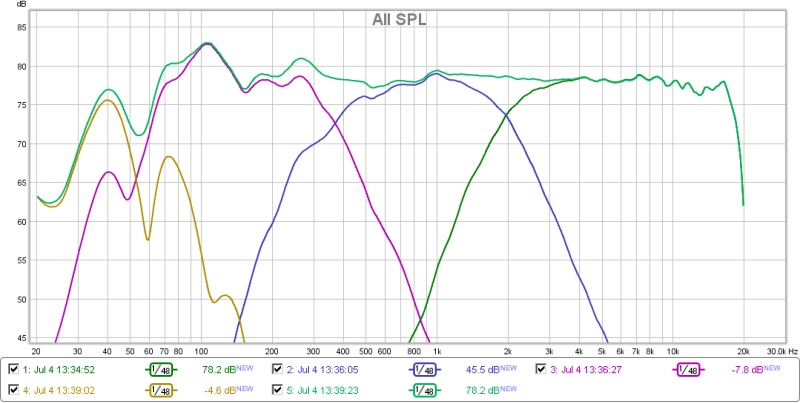
Then overall voicing. If you measurement distance was 1-2m (3-6ft) you certailnly should make the response solping downwards starting from 1000hz and a bit more in upper register, depending on your tweeter radiation pattern. just try different settings a listen.
You should also check REW delay graph to see how different frequencies decay(die) in your room. I have lots of window area and range 2-4kHz rings longer - speaker response might need bbc-dip then! Looks like you have good crossovers, now you can focus on voicing - I am almost settled now after two years of playing with minidsp an a 4-way speaker!
Take a look at upper mid response just below 1000hz. The step we see is most likely baffle diffraction peak. Try setting a step with negative dB value and applicable Q to straighten that! Try also setting tweeter xo to around 3,5kHz, it will change power response to more mellow upper mid!

Then overall voicing. If you measurement distance was 1-2m (3-6ft) you certailnly should make the response solping downwards starting from 1000hz and a bit more in upper register, depending on your tweeter radiation pattern. just try different settings a listen.
You should also check REW delay graph to see how different frequencies decay(die) in your room. I have lots of window area and range 2-4kHz rings longer - speaker response might need bbc-dip then! Looks like you have good crossovers, now you can focus on voicing - I am almost settled now after two years of playing with minidsp an a 4-way speaker!
Last edited:
Jojip, one notion about midrange harshness,
Take a look at upper mid response just below 1000hz. The step we see is most likely baffle diffraction peak. Try setting a step with negative dB value and applicable Q to straighten that! Try also setting tweeter xo to around 3,5kHz, it will change power response to more mellow upper mid!

Then overall voicing. If you measurement distance was 1-2m (3-6ft) you certailnly should make the response solping downwards starting from 1000hz and a bit more in upper register, depending on your tweeter radiation pattern. just try different settings a listen.
You should also check REW delay graph to see how different frequencies decay(die) in your room. I have lots of window area and range 2-4kHz rings longer - speaker response might need bbc-dip then! Looks like you have good crossovers, now you can focus on voicing - I am almost settled now after two years of playing with minidsp an a 4-way speaker!
Thanks Juhazi. I will try out the suggestions and see how that goes.
3.5KHz might be too high due to C2C concern and directivity matching, but i will give that a shot to see if i prefer that.
- Status
- Not open for further replies.
- Home
- Loudspeakers
- Multi-Way
- Advice needed on 4 Way loudspeaker
